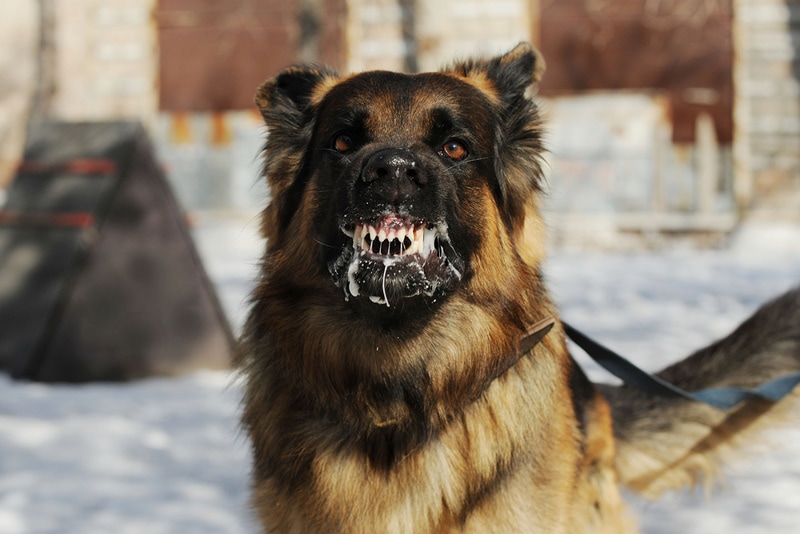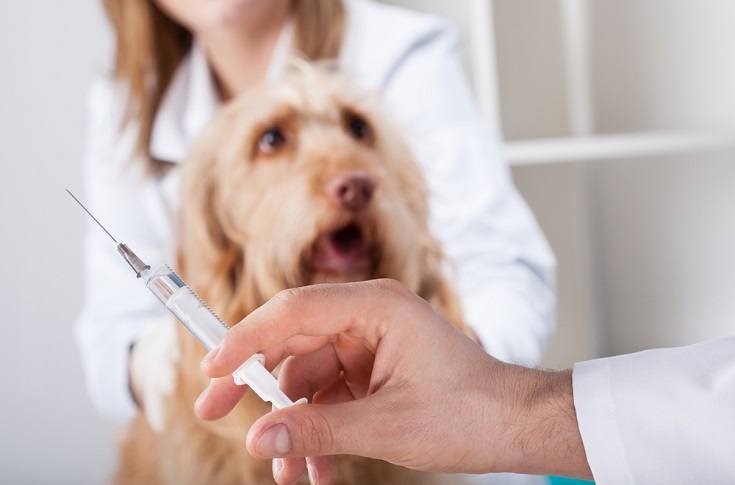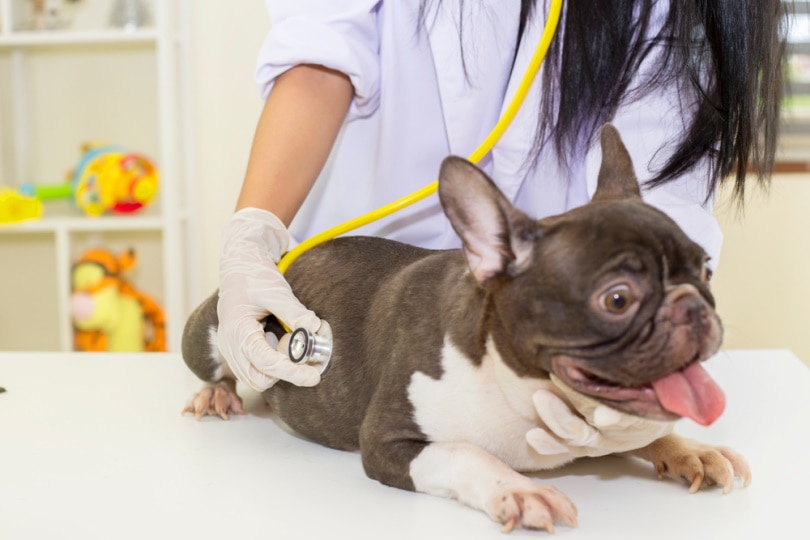Rabies in Dogs: Causes, Signs & Care Guide (Vet Answer)

Updated on

Rabies is caused by a virus that is found all over the world and affects all mammals, including dogs, cats, and humans. It is one of the most dangerous diseases our furry friends can face. This viral disease infects the brain and spinal cord and is fatal in 100% of cases.
The signs of rabies are specific (the classic “mad dog”), but the initial phase is often confused with a cold. For these reasons, dog owners do not know their pet is infected with rabies until the signs are obvious.
Fortunately, you can prevent your dog from becoming infected with this fatal virus if you vaccinate it regularly with a rabies vaccine. Read on to learn more.
What Is Rabies?
Rabies is an infectious disease found in all species of mammals that is transmissible to humans and caused by the rabies virus. This virus is a neurotropic RNA virus (i.e., with an affinity for the nervous system) of the Lyssavirus genus, Rhabdoviridae family. Clinically, the disease is characterized by nervous disorders, manifested by hyperesthesia (excessive sensitivity) and aggression, followed by paralysis and death.
In humans, this disease used to be called hydrophobia because it seems to cause people to fear water (indirectly). The explanation is that rabies causes intense throat spasms when an infected person tries to swallow. Sometimes even the thought of swallowing can cause spasms and fear.
The rabies virus is found in the saliva of infected animals and is usually transmitted through biting. It is found especially in raccoons, skunks, bats, and foxes in the USA, foxes in Europe, and wildlife and stray dogs in Africa, Asia, and Latin America.
Among domestic animals, rabies occurs most frequently in dogs (80–90% of cases), followed by cats. The incubation period (the time from infection to the first signs) in dogs is usually two weeks to three months, but there are cases in which the clinical signs occurred in a few days.
The speed at which clinical signs develop depends on several factors, such as:
- The severity of the bite
- The site of infection (the closer the bite is to the brain and spinal cord, the faster the virus will reach the nervous tissue
- The amount of virus injected through the bite
- Immunity
In humans, cases of rabies have also been reported seven years after exposure to the virus.
The sources of infection are sick animals, which eliminate the virus through their saliva, and animals in the incubation period, which eliminate the virus through their saliva no more than ten days before the clinical signs occur.
 What Are the Signs of Rabies?
What Are the Signs of Rabies?
At the beginning of the infection, dogs will show only mild signs of central nervous system abnormalities, which will last from one to three days. During this time, dogs that are usually quiet become more agitated, and those that are active and lively become nervous, shy, and “lazy”. At the same time, dogs can become very affectionate or more withdrawn than usual. After this period, the disease evolves in one of the following forms or a combination of the two:
1. Furious form
It occurs when the rabid dog becomes aggressive (the classic “mad dog” syndrome) and shows evidence of a depraved appetite, including eating dirt or rocks. Another characteristic of this form is the change in temperament of dogs. They isolate or consume a large amount of water (excessive thirst). Dogs do not show hydrophobia.

- Sensitivity to noise, light, or any touch
- Voice change
- The desire to leave the cage or home
In this form, paralysis eventually sets in, and the rabid animal becomes unable to eat or drink water and will also exhibit excessive salivation.
2. Paralytic form (also known as dumb/apathetic form)
It is the most common form of rabies in dogs and involves progressive paralysis of the limbs, facial distortion, and difficulty swallowing. In the case of the latter clinical sign, many pet owners tend to confuse rabies with the possibility of an object stuck in their dog’s mouth or throat. For this reason, it is important to watch the other signs as well as the entire behavior of your quadruped very carefully.
- Confused look
- Sadness
- Difficulty responding to owner’s commands
What Are the Causes of Rabies?
The rabies virus is transmitted through direct contact, either through the bite of an infected dog to a healthy dog or through an open wound that is exposed to the saliva of an infected animal (e.g., through licking). Transmission of the virus can also occur when infected saliva comes into contact with the mucous membranes of the eyes, nose, or mouth.
Other types of contact, such as contact with the blood, urine, or feces of a rabid animal, are not associated with the risk of infection.
The rabies virus can directly enter the peripheral nervous system and migrate to the brain or replicate in muscle tissue, where it is sheltered from the host’s immune system. From here, it enters the nervous system through neuromuscular junctions (where nerves and muscle fibers meet) and reaches the brain.
The greatest risk of infection is presented by dogs that are exposed to interaction with wild animals. Pets that never leave the apartment have a very low risk of being exposed to the rabies virus.

How Do I Care for a Dog With Rabies?
There is no specific test to diagnose the disease in live animals, and there is no treatment for rabies once the clinical signs have set in. Therefore, pets that are suspected of infection must be euthanized. Confirmation of the diagnosis can only be done postmortem through an antibody test.
If your pet was bitten by a rabid animal but is vaccinated against rabies, it will receive a booster anti-rabies vaccine from the veterinarian.
Unfortunately, rabies is always fatal for unvaccinated pets. Thus, an unvaccinated dog that is bitten by or exposed to a known rabid animal must be quarantined for up to four months or following local and state regulations if the owner refuses euthanasia.
How to Prevent Rabies
Rabies is no joke, and therefore, dog vaccination is mandatory. The most effective way to reduce the risk of rabies is the rabies vaccine, which promotes the production of antibodies. This vaccine is part of the series of mandatory vaccines and is included in the vaccination schedule for junior dogs.
The first rabies vaccine is given to your puppy when it is 14–16 weeks of age (~ three months). The first booster is administered after one year, and depending on the state legislation and the type of vaccine your vet uses, the following boosters are administered every 1–3 years. Your dog’s immunization is obtained 28 days after vaccination. Therefore, it is recommended not to let your puppy come into contact with wild or rabid animals during this time.
Vaccination is the only method to control the evolution and transmission of the disease. The rabies vaccine is also useful for human safety because, as previously mentioned, rabies is a transmissible disease from animals to humans.
It is very important to note that the rabies vaccine is only effective if it is administered before the virus enters the nervous system.

Frequently Asked Questions (FAQs)
How Do You Know a Dog Has Rabies?
At first, rabies can be confused with a cold, often showing signs of a fever, apathy, and loss of appetite. As the disease progresses, more specific signs begin to appear, such as difficulty swallowing, aggressivity, excessive salivation, paralysis, and seizures. Dogs also become more sensitive to light and noise. The diagnosis of rabies can only be established postmortem. Therefore, dogs suspected of rabies are euthanized.
How Long Does It Take for a Dog to Show Signs of Rabies?
Although the incubation period of rabies can vary from several weeks to months, signs of the disease can also appear within 3–5 days of contact with a rabid animal. However, the time that passes from the moment of exposure to the virus to the appearance of the first clinical signs depends on certain factors: the biting site (the closer it is to the head or spine, the faster the infection settles in the brain), the immune system, and the amount of saliva injected at the bite site.
Can a Dog With Rabies Survive?
Dogs with rabies do not survive unless they are vaccinated. Once the clinical signs have occurred, the disease is fatal in 100% of cases. Death usually occurs within seven days of illness. Vaccinated dogs that have been exposed to the rabies virus will receive a rabies booster from the veterinarian. Unvaccinated dogs will be kept in isolation and under observation for four months or as long as the law requires.
Conclusion
Rabies is a dangerous and fatal disease found in all mammals, including dogs and humans. It affects the brain and nervous system and is transmitted through infected saliva.
It has no treatment and is fatal in 100% of cases once the clinical signs have occurred. Because it is such a severe disease, vaccinating your puppy is mandatory. Unvaccinated dogs that have come into contact with a rabid animal must be euthanized. If the owner refuses to euthanize their dog, they should keep their pet in quarantine for four months. Vaccinated dogs will receive a rabies booster from the veterinarian, not needing isolation and observation.
Featured Image Credit: simonocampo999, Pixabay


 What Are the Signs of Rabies?
What Are the Signs of Rabies?












